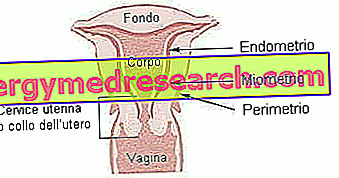See also: endometrial polyps
Key points
Uterine polyps are soft growths, pedunculated or sessile and generally benign, growing along the endometrial or cervical tract of the uterus.
Causes
The precise cause responsible for the uterine polyposis is not known. It is hypothesized that the development of polyps in the uterus depends on the excessive growth of endometrial cells, linked to estrogenic alterations.

Symptoms
When symptomatic, the presence of the uterine polyp must be hypothesized in the following cases: irregular menstrual cycle, dysmenorrhea, hypermenorrhea, menorrhagia, spotting.
Diagnosis
The diagnosis of uterine polyposis can be ascertained by transvaginal ultrasound examination, curettage, diagnostic hysteroscopy or hysterosalpingography.
Therapy
The benign and small uterine polyps do not require any specific treatment. Sometimes, pharmacological therapy (progestins or gonadotropins) may be necessary. Large uterine polyps must be surgically removed (therapeutic hysteroscopy or hysterectomy).
Uterine polyp: definition
Uterine polyps are benign neoformations that grow along the endometrial or cervical tract of the uterus. These are generally pedunculate soft growths that, sticking to the inner wall of the uterus, project directly into the uterine cavity.
Step back to understand ...
- Endometrium: mucous membrane that covers the uterine cavity internally
- Cervix (or cervix): lower portion of the uterus adjacent to the upper part of the vagina (lower) and to the uterine isthmus (above)
Uterine polyps consist of a tissue rich in mucous glands. By increasing in volume, the fabric - already extremely fragile and delicate in itself - can cause bleeding, sometimes even very copious.

Uterine polyps can be classified based on how they are anchored to the uterine wall:
- Pedunculated uterine polyps: they are fixed to the uterine mucosa by a peduncle. More often, these growths remain confined within the uterus; however, although rarely, they can protrude into the vagina
- Sessile uterine polyps: they are anchored to the uterine mucosa with their entire base and, not being pedunculated, cannot protrude into the vagina.
Uterine polyps can appear in women of all races and ages, therefore developing both during a woman's fertile period and after (rare) menopause. However, the peak incidence is recorded between the ages of 40 and 50, while it is rare that the phenomenon affects adolescents.
Causes
Although the main cause responsible for the formation of uterine polyps has not yet been clarified with certainty, it is hypothesized that their development depends on an abnormal and excessive growth of endometrial cells.
It seems that the hormonal factors play an essential role in the etiopathogenesis: in fact, the uterine polyps are estrogen-sensitive, meaning that they respond to estrogens similar to the endometrium.
Risk factors for uterine polyposis include:
- Age between 40 and 50 years
- Genetic predisposition
Uterine polyps: symptoms
To learn more: Symptoms Uterine polyps
The clinical symptoms of uterine polyps are not very evident: many women do not perceive the presence of a polyp as long as they do not undergo a standard gynecological examination.
However, the uterine polyps are prone to bleeding, so abnormal uterine losses - outside of the menstrual cycle - can be a lit indicator of a uterine polyp.
When symptomatic, uterine polyps can cause different discomforts:
- Irregular menstrual cycle
- Dysmenorrhea (painful menstruation) accompanied by severe abdominal cramps
- Dyspareunia (pain during sexual intercourse)
- Hypermenorrhea (copious menstruation) or menorrhagia (extremely abundant blood loss during menstruation)
- Uterine loss similar to menstruation during the post-menopausal period
- Spotting
A polyp can create complications when it grows near the fallopian tubes, especially when its size is important. In such circumstances, in fact, the uterine polyp can obstruct the openings of the tubes, hindering fertilization and becoming a possible cause of infertility.
- Most uterine polyps are a benign condition: the probability of degeneration in tumors is very low.
Diagnosis
To date, the transvaginal ultrasound examination allows the localization of uterine polyps in asymptomatic patients.
Uterine polyps can also be diagnosed by curettage: the tissue sample taken will then be examined in the laboratory to rule out a possible malignant lesion. Hysteroscopy is also sometimes performed to confirm a suspicion of a uterine polyp: this technique uses a special instrument (hysteroscope) to view the inside of the uterine cavity. Diagnostic hysteroscopy is a fundamental investigation in the differential diagnosis of the various causes of menstrual alteration (including uterine polyposis).
Last but not least, hysterosalpingography, a radiological test useful for assessing the state of health of the uterus and fallopian tubes.
Therapy
To learn more: Drugs for the treatment of uterine polyps.
Small benign uterine polyps tend to self-purify over a short period, although it is advised to keep them under control to avoid a possible (albeit unlikely) neoplastic evolution.
There is also a drug therapy for the treatment of uterine polyps. However, the intake of progestins or gonadotropins is not the best choice to eliminate uterine growths, since the risk of recurrence is very high.
Although this is an almost harmless and benign condition, large uterine polyps must be treated surgically, since they can create considerable menstrual discomforts.
The therapy consists in the exeresis of the polyp, or in its surgical removal:
- Hysteroscopy (therapeutic): consists in the complete surgical removal of the uterine polyp
- Hysterectomy (removal of the uterus): indicated when the uterine polyps contain malignant neoplastic cells
Even after a perfectly successful surgical treatment, the uterine polyps tend to recur. On the occasion of a recurrence, the woman will have to undergo a further operation.



